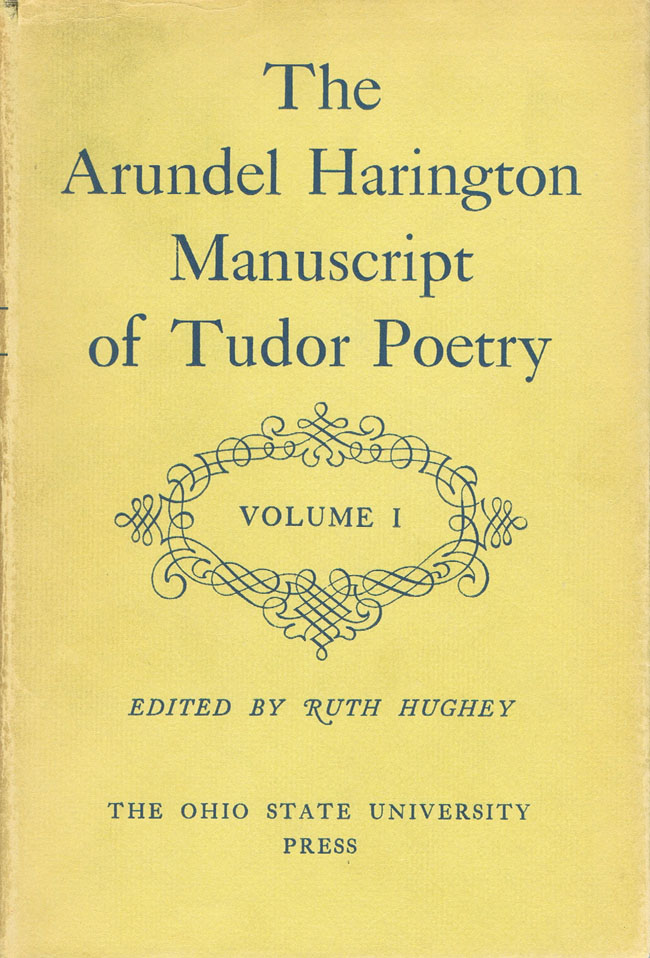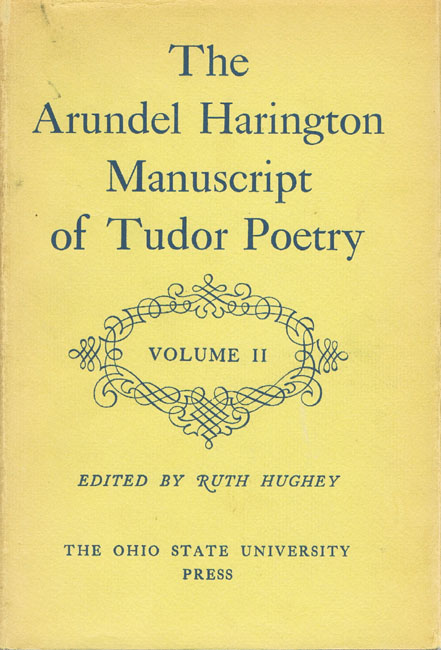The Arundel Harington Manuscript of Tudor PoetryVolumes 1 and 2Edited by Ruth Hughey |
  1960 Literary Collections / English, Irish, Scottish, Welsh Volume I 428 pp. 6x9 Volume 2 529 pp. 6x9 |
|||
|
read the full text of Volume 1 (Open Access) |
In 1934, in the library at Arundel Castle, while searching for compositions by Elizabethan women, Ruth Hughey came across a handsome folio volume containing more than three hundred poems of the Tudor era. Her discovery was of primary importance, for the work proved to be one of two poetry manuscripts borrowed from those preserved by the Harington family by Dr. George Frederick Nott, who used them in preparing his elaborate two-volume edition of Surrey and Wyatt at the beginning of the nineteenth century. The first of these two, the Wyatt autograph volume, which Nott designated “Harington MS. No.I,” was readily available to the early twentieth-century editors of the poetry of Wyatt and Surrey, in the Egerton collection at the British Museum; but the whereabouts of its companion volume, which Nott had designated “Harington MS. No. II,” was unknown to scholars, and it was said to have disappeared. Miss Hughey has restored it to the world of Tudor scholarship. The present work is the result of her long and intensive study of the manuscript, its provenance, its relation to contemporary manuscripts and books, and its importance as a record of Tudor poetry. Compiled by John Harington of Stepney and Sir John Harington of Kelston, the Arundel manuscript contains poems ranging from the time of Henry Howard Earl of Surrey, Sir Thomas Wyatt, and Sir John Cheke, to the period of Edward de Vere Earl of Oxford, Sir Philip Sidney, Sir Walter Ralegh, adn Henry Constable. It contains two poems by Queen Elizabeth I, one of which is printed here for the first time—as are more than seventy others in the collection, some of which are by hitherto unknown authors. In addition, there are other pieces which have appeared only in obscure publications, and still others that present variant texts which contribute to our understanding of Tudor taste, applied poetics, and editorial method. At the closer of her Introduction, Miss Hughey writes: “To the two John Haringtons of Stepney and Kelston for their labor of love in preserving the Wyatt autograph manuscript and in forming their two contemporary poetry miscellanies. . ., were are very much in debt for our knowledge of the progress of English verse struggled upward through four Tudor reigns. Without these manuscripts our understanding of early and mid-Tudor poetry would be more imperfect than it now is, and our knowledge of the later poetry less complete.” Now Professor of English at The Ohio State University,Miss Hughey was introduced to literary scholarship and research at Columbia and Cornell Universities, from which she holds the M. A. and Ph. D. degrees, respectively. An Hon.D.Litt. degree from Hendrix College, from which she also received the A. B. degree, was bestowed in recognition of her work. Awards of fellowships from the American Association of University Women and the Yardley and Guggenheim Foundations, and the receipt of the Elizabeth Clay Howald Fellowship, have enabled her to carry on her researches in the United States and in England. Miss Hughey is a distinguished and popular teacher, the editor of The Correspondence of Lady Katherine Paston, 1603–1625, and the author of a number of articles on literature of the English Renaissance. | |||

